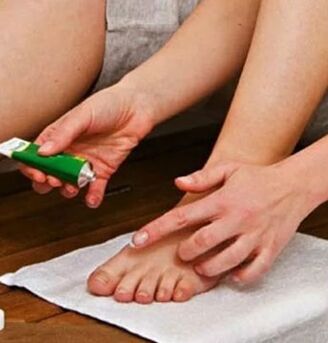
Fungal diseases are very often diagnosed in dermatology. Walking barefoot on the beach, lack of shoes that can be changed while visiting saunas and baths, trying on other people’s shoes, boots, etc. contribute to the widespread spread of disease on the toes. According to statistics, damage to the nail plate most often begins with the thumb. This is due to the peculiarities of the anatomical structure of the nail and the significant subungual space. If you get timely medical help, the disease will not bring much discomfort and will be nothing more than a temporary cosmetic defect.
Symptoms of the disease
Getting under the nail plate, the fungal infection quickly finds a nutrient medium for itself and begins active reproduction. During this period, a person may not experience any symptoms, or slight itching, redness in the nail area appears. Further, the growth of pathogenic colonies leads to more obvious signs, they are a reason to seek advice from medical institutions. If you treat nail fungus on the big toe at an early stage, you can avoid many unpleasant complications. The main symptoms include:
- changes in nail color;
- the appearance of spots beneath it;
- lack of natural luster;
- increased fragility;
- nail defects.
The longer the disease is not treated, the more negative the effect of the fungus: the body of the nail becomes thicker, its shape changes significantly. Such fingers cause pain when trying to wear tight shoes or in the event of an unintentional mechanical injury. In the future, nails completely lose their healthy appearance, crumble, flake off and can come off the base of the nail.
Causes of fungus on the big toe
The causative agents of this disease are three groups of pathogenic fungi: such as yeasts, molds and dermatomycetes. Their prevalence in the environment is very high, so there are many ways of infection. However, not everyone is infected with harmful contact, because immunity acts to protect health. Treatment for fungus on the big toe is often needed for people who are less resistant to this type of infection. In addition, the disease can be provoked by:

- frequent injuries to the thumb;
- non -compliance with hygiene standards;
- the presence of fungal skin lesions;
- diabetes;
- overweight;
- vascular disease;
- varicose veins on the lower part of the leg.
Weak immunity occupies a special place among the predisposing factors. Past viral infections, frequent colds, sore throats, poisoning weaken the body’s defenses against fungal infections and increase the risk of infection. In addition, nutrient deficiencies and the frequent formation of cracks and other injuries in the big toe area reduce local immunity and can trigger disease.
Which doctor should I call?
If you have started to worry about any unpleasant symptoms associated with toenails, you should seek medical advice as soon as possible. Itching, redness, discoloration may indicate an impending disease. Qualified assistance in this matter will be provided by a physician.
He specializes in various skin diseases and will help to efficiently treat nail fungus on the big toe. First, a comprehensive diagnosis is performed, including collection of anamnesis, examination and passage of several laboratory tests. For a more complete assessment of the patient’s condition, a dermatologist may prescribe some supplements question:
question:
- How long have you noticed changes in your nails?
- What is the first thing to worry about?
- Has the nail plate changed color?
- How long does it take for the form to change?
- What kind of activities do you do?
- Do you often visit the sauna, bath?
- Have you ever had a fungal infection on the body?
After passing the additional examination, the patient should visit the dermatologist again. Based on the results obtained and the clinical picture, the doctor prescribes therapy of the disease.
Treatment
The effectiveness and duration of therapy for this disease directly depends on obtaining early medical help and the right scheme. In the early stages of the disease, ointments and gels for external use containing antifungal components are an effective means. In this case, it is important to properly identify the pathogen and deal with it. Other treatments can also be done:
- complex therapy;
- physiotherapeutic effects;
- laser therapy;
- nail removal;
- elimination of comorbidities.
In cases of more complex pathology, an integrated approach is indicated, including antifungal drugs for local and internal use, general tonics. In addition to drug treatment is a low -sugar diet. He is the one who creates favorable conditions for the reproduction of parasitic fungi. For a faster recovery process, we recommend:
- taking vitamin complexes;
- to lead an active lifestyle;
- perform daily sanitation procedures;
- follow the treatment regimen strictly;
- reject bad habits.
An important place in the final stages of therapeutic measures is the prevention of relapse and strengthening of immunity. Patients are not advised to walk barefoot on the beach, try on other people’s shoes and allow feet to sweat frequently.
Possible Complications
Aesthetic defects are far from all that fungi can do. In further cases, the nail becomes too large, very painful, grows into the adjacent skin, there is a possibility of secondary infection and purulent lesions may merge. Toenail fungus treatment in this case will be a long and arduous process. In addition to local negative effects, pathogens have effects that destroy the whole organism, the following are possible:
- allergies;
- dermatitis;
- blood poisoning;
- drunk;
- somatic diseases.
When fungal strains reach large numbers, their waste products become poisonous, poisoning a person and depleting his or her immune system. In this situation, the likelihood of multiple viral or bacterial lesions is very high. There was a significant deterioration in overall health and performance.















